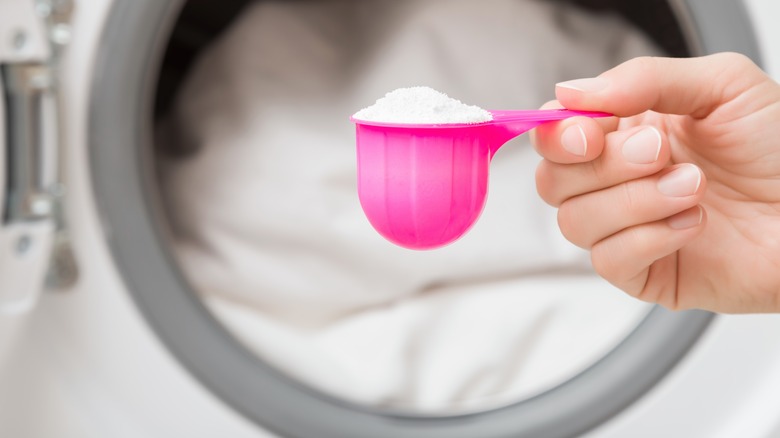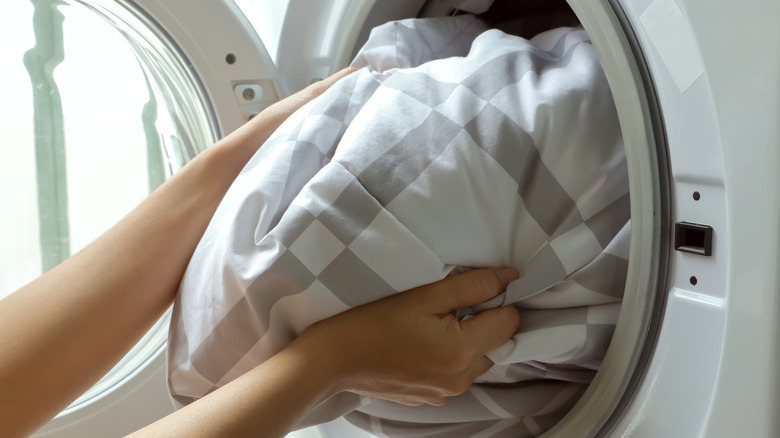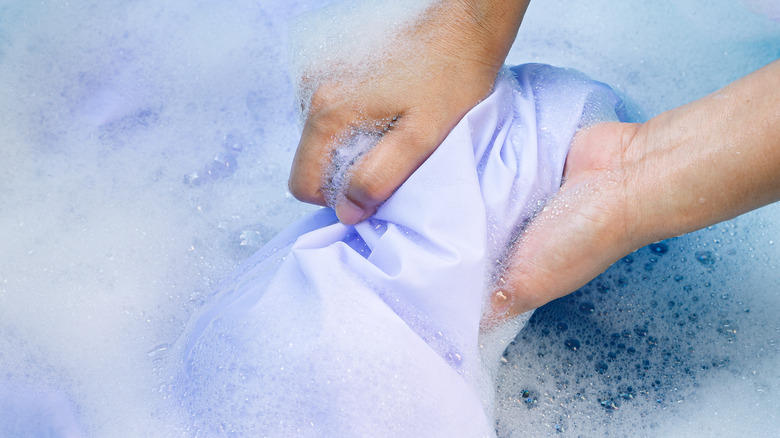How To Wash Weighted Blankets With Glass Beads On Laundry Day
If you have a weighted blanket with glass beads, you probably love it. However, you need to wash your weighted blankets (sometimes called gravity blankets) to keep enjoying the sensory comfort. Otherwise, the accumulated sweat, body oils, dead skin cells, and the occasional stains will turn your blanket unhygienic and reduce its lifespan. But before you pour in the detergent, however, check the care label to determine if it's safe to pop it in the washing machine or whether it should be hand-washed to avoid harming your precious weighted blanket with glass beads. With that said, don't skip an important step before starting a load of laundry: forgetting to pre-treat stains. Concoct a solution of equal parts bleach-free detergent and water and apply with a toothbrush to loosen any visible stains. Don't wash it too frequently, or you risk damaging its fill.
To err on the side of caution, wash your glass bead-filled weighted blankets every quarter. That being said, if you sweat a lot, make a habit of washing it every two months (or sooner if it begins smelling bad). If you don't use it year-round, washing it a few times annually should do the trick. Remember, this recommended frequency is for the blanket, not its cover. A blanket's removable cover should be cleaned weekly or bi-weekly, depending on how dirty it gets. If your weighted blanket doesn't come with a cover, you should get one.
How to machine wash weighted blankets with glass beads
To machine wash your weighted blanket with glass beads, determine its weight. This is important because they can weigh anywhere between 5 and 30 pounds. While your residential-capacity washer can easily handle clothes around 20 pounds, it's best to take your blanket to a laundromat if it weighs more to avoid witnessing the dangers of overloading your washing machine. The commercially sized machines can handle the load and won't damage your large blankets. Then, ensure the washer is empty (there should be no other items), take off your blanket's washable cover, and place it inside. The blanket should be spread even, not bunched up, for a thorough cleaning. Select the cold, delicate cycle with no spin to avoid agitating the glass microbeads.
Next, add a mild detergent to the correct compartment since bleach can damage the material and fill. Steer clear of fabric softeners, as they might accumulate on the surface and make your fluffy weighted blanket rougher. Finally, step back and let your washer clean your dirty blanket. Don't hesitate to pause the cycle if the machine lets out unusual noises, as this could indicate the blanket isn't spread evenly or the washer is overloaded. After the blanket is clean, take it out and check the care label again to discern if it's okay to place it in the dryer. If not, lay it flat and leave it to air dry.
How to hand-wash weighted blankets with glass beads
To hand-wash your weighted blankets with glass beads, plug your bathtub (or sink, provided it can accommodate and handle the weight of the blanket) and fill it halfway through with cold water. Don't forget to check if the tub is free of dirt and soap scum. Once satisfied, add ½ cup of mild laundry detergent to the tub and swirl it around to help it dissolve. Now, peel off the removable cover and drop the blanket in the tub. Use your hands to immerse it beneath the soapy water. Gently rub it all over to loosen the accumulated dirt prior to leaving it to soak for 15 to 30 minutes, depending on how dirty it is.
After the time is up, hold the blanket with one hand and pull the plug with another to drain the soap water. Drop it back in, refill the tub with clean water, and submerge the blanket to remove the detergent. You may have to repeat this step one to two more times to rinse out the blanket well, as leftover soap might cause the glass beads to clump. Once clean, spread it as well as you can in the tub and roll it gently to squeeze out the excess water. Finally, carry it out, put down a clean plastic tarp or sheet, and lay the blanket across the surface to let it air dry. Don't hang it, or the beads will collect on either end.


